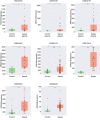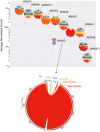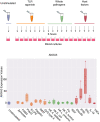Annexin A3 in sepsis: novel perspectives from an exploration of public transcriptome data
- PMID: 32682335
- PMCID: PMC7692248
- DOI: 10.1111/imm.13239
Annexin A3 in sepsis: novel perspectives from an exploration of public transcriptome data
Abstract
According to publicly available transcriptome datasets, the abundance of Annexin A3 (ANXA3) is robustly increased during the course of sepsis; however, no studies have examined the biological significance or clinical relevance of ANXA3 in this pathology. Here we explored this interpretation gap and identified possible directions for future research. Based on reference transcriptome datasets, we found that ANXA3 expression is restricted to neutrophils, is upregulated in vitro after exposure to plasma obtained from septic patients, and is associated with adverse clinical outcomes. Secondly, an increase in ANXA3 transcript abundance was also observed in vivo, in the blood of septic patients in multiple independent studies. ANXA3 is known to mediate calcium-dependent granules-phagosome fusion in support of microbicidal activity in neutrophils. More recent work has also shown that ANXA3 enhances proliferation and survival of tumour cells via a Caspase-3-dependent mechanism. And this same molecule is also known to play a critical role in regulation of apoptotic events in neutrophils. Thus, we posit that during sepsis ANXA3 might either play a beneficial role, by facilitating microbial clearance and resolution of the infection; or a detrimental role, by prolonging neutrophil survival, which is known to contribute to sepsis-mediated organ damage.
Keywords: annexin; bacteremia; cell proliferation; endotoxemia; immunity; inflammation; neutrophil; sepsis; transcriptome.
© 2020 The Authors. Immunology published by John Wiley & Sons Ltd.
Conflict of interest statement
The authors declare that they have no conflict of interest.
Figures




Similar articles
-
Annexin A3 upregulates the infiltrated neutrophil-lymphocyte ratio to remodel the immune microenvironment in hepatocellular carcinoma.Int Immunopharmacol. 2020 Dec;89(Pt A):107139. doi: 10.1016/j.intimp.2020.107139. Epub 2020 Nov 13. Int Immunopharmacol. 2020. PMID: 33191179
-
Tumor-Suppressing Effect of Silencing of Annexin A3 Expression in Breast Cancer.Clin Breast Cancer. 2018 Aug;18(4):e713-e719. doi: 10.1016/j.clbc.2017.11.009. Epub 2017 Nov 21. Clin Breast Cancer. 2018. PMID: 29217453
-
Annexin A3 promotes tumorigenesis and resistance to chemotherapy in hepatocellular carcinoma.Mol Carcinog. 2015 Aug;54(8):598-607. doi: 10.1002/mc.22126. Epub 2013 Dec 23. Mol Carcinog. 2015. PMID: 24375474
-
The role of annexin A3 playing in cancers.Clin Transl Oncol. 2013 Feb;15(2):106-10. doi: 10.1007/s12094-012-0928-6. Epub 2012 Aug 22. Clin Transl Oncol. 2013. PMID: 23011854 Review.
-
Long-Chain Acyl-CoA Synthetase 1 Role in Sepsis and Immunity: Perspectives From a Parallel Review of Public Transcriptome Datasets and of the Literature.Front Immunol. 2019 Oct 18;10:2410. doi: 10.3389/fimmu.2019.02410. eCollection 2019. Front Immunol. 2019. PMID: 31681299 Free PMC article. Review.
Cited by
-
Identification of a Four-Gene Signature for Diagnosing Paediatric Sepsis.Biomed Res Int. 2022 Feb 14;2022:5217885. doi: 10.1155/2022/5217885. eCollection 2022. Biomed Res Int. 2022. Retraction in: Biomed Res Int. 2024 Mar 20;2024:9868941. doi: 10.1155/2024/9868941. PMID: 35198634 Free PMC article. Retracted.
-
Detailed Transcriptional Landscape of Peripheral Blood Points to Increased Neutrophil Activation in Treatment-Naïve Inflammatory Bowel Disease.J Crohns Colitis. 2022 Aug 4;16(7):1097-1109. doi: 10.1093/ecco-jcc/jjac003. J Crohns Colitis. 2022. PMID: 35022690 Free PMC article.
-
Analysis of local extracellular matrix identifies different aetiologies behind bicuspid and tricuspid aortic valve degeneration and suggests therapies.Cell Mol Life Sci. 2023 Aug 26;80(9):268. doi: 10.1007/s00018-023-04926-1. Cell Mol Life Sci. 2023. PMID: 37632572 Free PMC article.
-
Proteomic Analysis of Meibomian Gland Secretions in Patients With Blepharokeratoconjunctivitis.Transl Vis Sci Technol. 2022 Dec 1;11(12):4. doi: 10.1167/tvst.11.12.4. Transl Vis Sci Technol. 2022. PMID: 36458945 Free PMC article.
-
A Neutrophil Extracellular Traps Signature Predicts the Clinical Outcomes and Immunotherapy Response in Head and Neck Squamous Cell Carcinoma.Front Mol Biosci. 2022 Feb 18;9:833771. doi: 10.3389/fmolb.2022.833771. eCollection 2022. Front Mol Biosci. 2022. PMID: 35252353 Free PMC article.
References
Publication types
MeSH terms
Substances
Grants and funding
LinkOut - more resources
Full Text Sources
Medical
Research Materials
Miscellaneous

